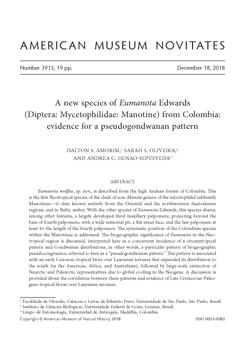Abstract
Eumanota wolffae, sp. nov., is described from the high Andean forests of Colombia. This is the first Neotropical species of the clade of non-Manota genera of the mycetophilid subfamily Manotinae—to date known entirely from the Oriental and the northwestern Australasian regions, and in Baltic amber. With the other species of Eumanota Edwards, this species shares, among other features, a largely developed third maxillary palpomere, projecting beyond the base of fourth palpomere, with a wide sensorial pit, a flat inner face, and the last palpomere at least 4× the length of the fourth palpomere. The systematic position of the Colombian species within the Manotinae is addressed. The biogeographic significance of Eumanota in the Neotropical region is discussed, interpreted here as a concurrent incidence of a circumtropical pattern and Gondwanan distributions, in other words, a particular pattern of biogeographic pseudocongruence, referred to here as a “pseudogondwanan pattern.” This pattern is associated with an early Cenozoic tropical biota over Laurasian terranes that expanded its distribution to the south (in the Americas, Africa, and Australasia), followed by large-scale extinction of Nearctic and Palearctic representatives due to global cooling in the Neogene. A discussion is provided about the correlation between these patterns and evidence of Late Cretaceous-Paleogene tropical floras over Laurasian terranes.






